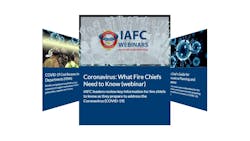IAFC Offering Best Practices in Weekly COVID-19 Webinar
Editor's note: Find Firehouse.com's complete coverage of the COVID-19 pandemic here.
The International Association of Fire Chiefs (IAFC) recently launched a COVID-19 Task Force that will provide valuable information and suggestions for best practices to firefighters and EMS personnel during a weekly webinar every Monday afternoon.
As the pandemic progresses across the United States in the coming weeks, chief officers and leadership personnel can easily access these webinars along with a host of helpful materials via the IAFC website's COVID-19 section, including a valuable "Guide for Coronavirus Planning & Response" document available to all.
The second webinar was broadcast on March 23 and offered recommendations and assessments concerning the outbreak, including issues such as the severe shortage of personal protective equipment facing emergency responders at the moment, which will hopefully soon be on its way to a resolution via manufacturing.
Some common sense best practices suggested to fire and EMS agencies included proper hand washing, physical distancing of at least 6 feet when you believe a patient may be infected, sterilization of ambulance interiors, and checking on personnel at the start of their shifts to effectively separate anyone who may be showing symptoms (runny nose, sore throat, dry cough, fever or difficulty breathing).
Current best practices for keeping apparatus and stations clean of cancer-causing carcinogens related to fire and extinguishment have become a major part of the fire service culture in recent years and can easily lead to the same smart and clean habits to avoid coronavirus infection, according to the Task Force.
Dr. James Augustine wished to make it clear that there is a great difference between someone being quarantined and isolated. Quarantine is a precautionary measure when someone may have been exposed but is not necessarily infected, while isolation occurs when a coronavirus infection is confirmed.
"We are currently at the 'community spread' portion of this outbreak," Dr. James Augustine, a Task Force member, said in a sobering moment. "Containment has failed."
Some of the more detailed recommendations concerned small things that many agencies probably have never encountered before and might overlook such as PPE conservation for continual use. With supplies running short, old habits of tossing medical PPE items like face masks after one use can't be allowed.
It was also strongly suggested that any administering of nebulizer be done outside and with other personnel at least six feet away and standing upwind due to the mist that is created in the patient's air pathways, which can easily spread infection.
Lastly, it was suggested that agencies track how the outbreak is affecting their finances and equipment. While things are still in the early stages in Washington as far as crafting legislation that can provide financial assistance to fire and EMS departments, Fire Chief John Sinclair, the Task Force chair, said there will be a process to obtain some of the money being allotted to help fight back the outbreak.
You can watch the first webinar from March 16 below:
The IAFC COVID-19 Task Force is comprised of the following:
- Fire Chief John Sinclair, Chair, IAFC President 2016-2017
- Dr. James Augustine, MD, FACEP; IAFC EMS Section
- Fire Chief Norvin Collins; IAFC Volunteer and Combination Officers Section
- Fire Chief Mike Duyck, Ret.; Metropolitan Fire Chiefs Association
- Assistant Chief Jo-Ann Lorber; IAFC Emergency Management Committee
- Fire Chief Dan Munsey; IAFC Technology Council
- Assistant Chief Nick Perkins; IAFC Safety, Health, and Survival Section
- Assistant Chief Bob Royall; IAFC Hazardous Materials Committee
- Mr. Richard Patrick; U.S. Fire Administration
- Dr. Jon Krohmer, National Highway Traffic Safety Administration
- Representatives from the International Association of Fire Fighters, American Medical Response, and a private medical supplies manufacturer
